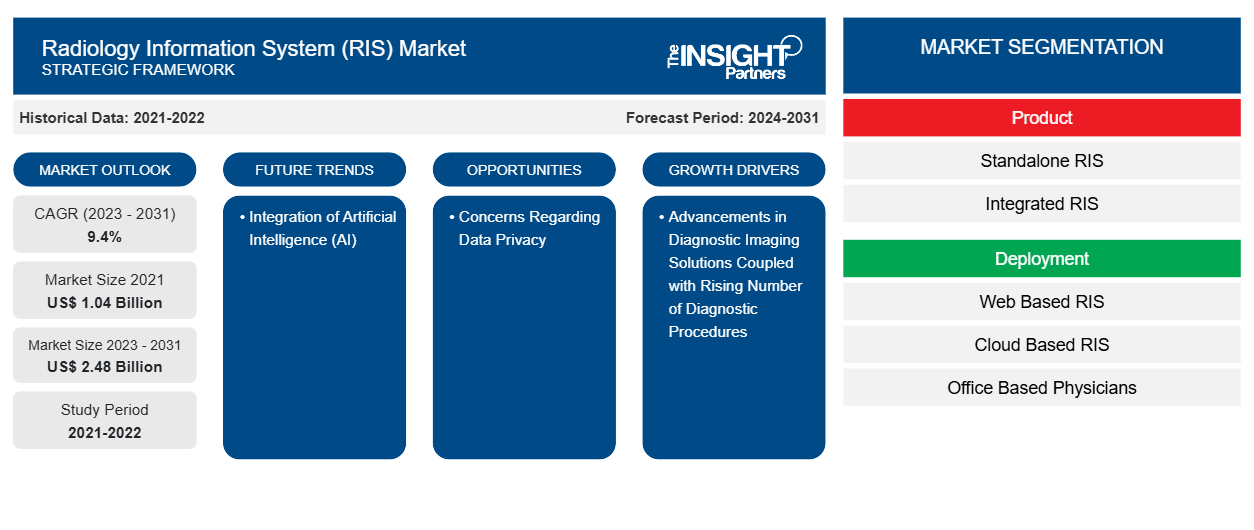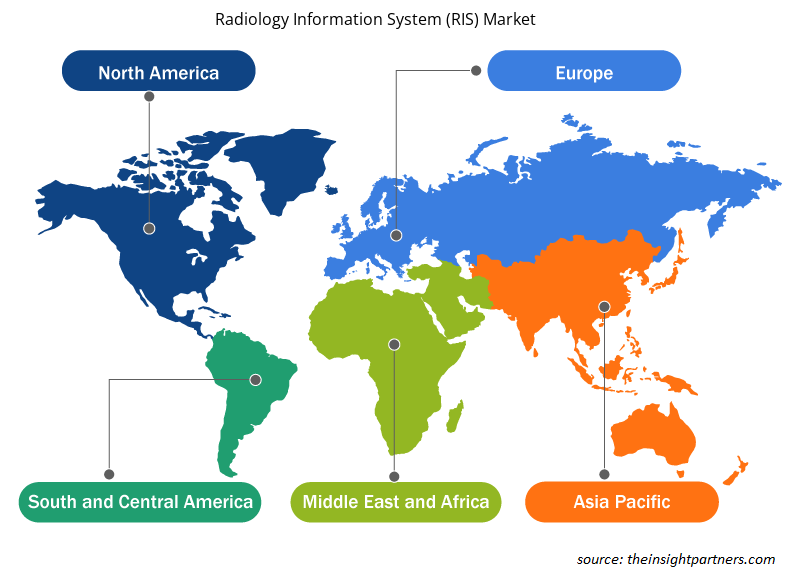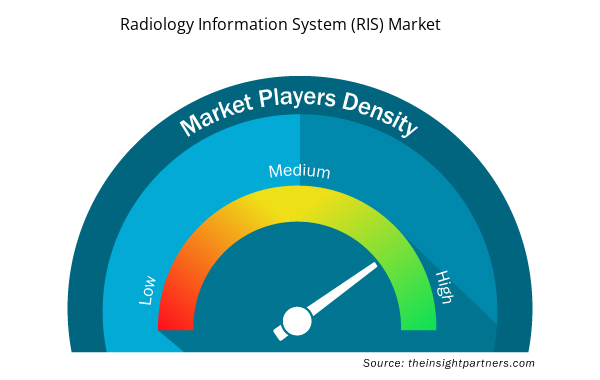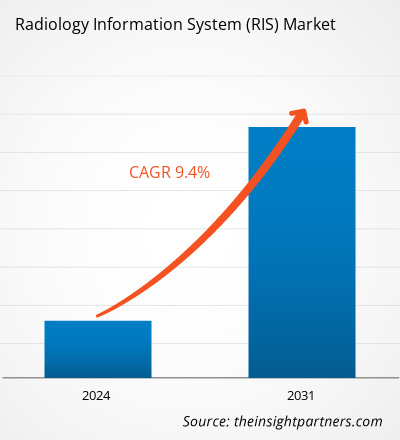The radiology information system (RIS) market size in 2021 stood at US$ 1.04 billion and is projected to reach US$ 2.48 billion by 2031 from US$ XX billion in 2023. The market is expected to register a CAGR of 9.4% in 2023–2031. Growing awareness regarding radiology information system (RIS) with its fewer health risks and adoption rate in the developing regions are likely to remain key radiology information system (RIS) market trends.
Radiology Information System (RIS) Market Analysis
Key market growth factors include increasing chronic disease incidence rates, access to healthcare information technology systems, and government funding for cancer research. Furthermore, the burden of chronic diseases is increasing worldwide, coupled with increasing population aging, and lifestyle-related disorders such as cancer, arthritis, cardiovascular diseases, and diabetes are some of the major factors responsible for the growth of this market. An increase in cancer cases is expected to lead to a elevated focus on radiology services for appropriate diagnosis, which is expected to increase the demand for radiology information systems. The increasing chronic diseases such as cancer is boosting the demand for radiology information systems. However, the high installation cost and lack of skilled labor are expected to hamper the market growth during the study period.
Radiology Information System (RIS) Market Overview
RIS is specialized healthcare software designed to manage and streamline the operations of radiology and imaging centers. The RIS stores, manage and distribute radiological images, patient information, and related data. Continuous technological advances, including machine learning, deep learning, and AI integration in healthcare, will improve the accuracy and efficiency of radiology systems. Additionally, the growing demand of integrated healthcare solutions for improving patient care and streamlining workflows is leading toward adopting RIS. Government regulations and initiatives also promote standardization of medical data and records. They also provide incentives for adopting healthcare IT services, which are expected to impact market growth opportunities positively.
Customize This Report To Suit Your Requirement
You will get customization on any report - free of charge - including parts of this report, or country-level analysis, Excel Data pack, as well as avail great offers and discounts for start-ups & universities
Radiology Information System (RIS) Market: Strategic Insights

- Get Top Key Market Trends of this report.This FREE sample will include data analysis, ranging from market trends to estimates and forecasts.
Customize This Report To Suit Your Requirement
You will get customization on any report - free of charge - including parts of this report, or country-level analysis, Excel Data pack, as well as avail great offers and discounts for start-ups & universities
Radiology Information System (RIS) Market: Strategic Insights

- Get Top Key Market Trends of this report.This FREE sample will include data analysis, ranging from market trends to estimates and forecasts.
Radiology Information System (RIS) Market Drivers and Opportunities
Advancements in Diagnostic Imaging Solutions to Favor Market
The introduction of digital imaging has transformed the field of radiology. It catalysed the transition from traditional film-based imaging to digital formats, optimized data management, and increased accessibility. Digital image processing also led to significant improvements in image quality. RIS allows healthcare staff to set appointments for individuals on both inpatient and outpatient bases. Radiology has advanced toward computerized management in the health service and has responded to the demand for cost-efficient and rapid communication between departments of radiology and their users. In the last few years, there have been various developments in imaging modalities within healthcare for diagnostic purposes. In recent years, many advances have been made in digital radiography, including AI-assisted X-ray interpretation, dual-energy imaging, tomosynthesis, computer-aided diagnosis, automatic image stitching, and digital mobile radiography. These advances have resulted in improved image quality, helping to improve patient care and achieve better patient outcomes. In addition, using digital radiography reduces the need for repeat imaging, which has the advantage of lower radiation exposure.
Growing Adoption of Healthcare IT Services in Emerging Economies – An Opportunity for Radiology Information System (RIS) Market Growth
Globally, there is a growing need for technology adoption in radiology services to meet the demands. The future of RIS lies in the usage of artificial intelligence (AI) and machine learning (ML). AI algorithms can help radiologists analyze images, detect abnormalities, and support decisions. ML algorithms can continuously learn from massive amounts of data and refine diagnoses and treatment plans. Improved connectivity through Internet and mobile technology, teleradiology, artificial intelligence, developments in medical imaging informatics, and portable or mobile medical imaging devices can enable remote locations in any country to access better healthcare and diagnostics. Furthermore, in developing countries, health systems are becoming more technologically friendly as the countries are experiencing an internationalization of care as established brands. For instance, the US-based Cleveland Clinic expanded their markets in the UAE, and England-based start-up Babylon, a primary care diagnostic app powered by machine learning and AI, entered into China and Rwanda.
Radiology Information System (RIS) Market Report Segmentation Analysis
Key segments that contributed to the derivation of the radiology information system (RIS) market analysis are product, deployment, component, and end user.
- Based on product, the radiology information system (RIS) market is bifurcated into standalone RIS and integrated RIS. In 2023, integrated RIS segment held the largest share of the market, and the same segment is anticipated to register the highest CAGR during the forecast period.
- By deployment, the market is segmented into web-based RIS, cloud-based RIS, on-premises RIS. In 2023, web-based RIS segment held the largest share of the market. However, the cloud-based RIS segment is anticipated to register the highest CAGR during 2023–2031.
- Based on component, the radiology information system (RIS) market is categorized into hardware, software, and services. In 2023, services segment held the largest share of the market, and the software segment is anticipated to register the highest CAGR during the forecast period.
- In terms of end user, the market is segmented into office-based physicians, hospitals, and emergency health service providers. In 2023, hospitals segment held the largest share of the market, and the same segment is estimated to register the highest CAGR during the forecast period.
Radiology Information System (RIS) Market Share Analysis by Geography
The geographic scope of the radiology information system (RIS) market report is mainly divided into five regions: North America, Asia Pacific, Europe, Middle East & Africa, and South America/South & Central America.
North America has dominated the radiology information system (RIS) market. The demand for the market in the region is expected to observe growth at a significant rate because of several factors such as government investment in healthcare infrastructure, increasing awareness regarding the medical imaging as well as the benefits associated with implementation of RIS. In the US factors such as large number of imaging centers in this region, swift pace of technological advancements, growing geriatric population and increasing demand for computer aided diagnosis, are some of the key growth drivers of this market. Also, presence of various companies engaged in developing advanced systems of RIS for diagnostic imaging of cardiovascular, orthopedic, dental and oncology is expected to offer growth opportunities for the market growth. However, Asia Pacific is predicted to grow with the highest CAGR in the coming years owing to factors such growth of the healthcare information technology industry in this region due to improving healthcare infrastructure and rise in rate of adoption of advanced health care techniques by consumers.
Radiology Information System (RIS) Market Regional Insights
Radiology Information System (RIS) Market Regional Insights
The regional trends and factors influencing the Radiology Information System (RIS) Market throughout the forecast period have been thoroughly explained by the analysts at Insight Partners. This section also discusses Radiology Information System (RIS) Market segments and geography across North America, Europe, Asia Pacific, Middle East and Africa, and South and Central America.

- Get the Regional Specific Data for Radiology Information System (RIS) Market
Radiology Information System (RIS) Market Report Scope
| Report Attribute | Details |
|---|---|
| Market size in 2021 | US$ 1.04 Billion |
| Market Size by 2031 | US$ 2.48 Billion |
| Global CAGR (2023 - 2031) | 9.4% |
| Historical Data | 2021-2022 |
| Forecast period | 2024-2031 |
| Segments Covered |
By Product
|
| Regions and Countries Covered | North America
|
| Market leaders and key company profiles |
Radiology Information System (RIS) Market Players Density: Understanding Its Impact on Business Dynamics
The Radiology Information System (RIS) Market market is growing rapidly, driven by increasing end-user demand due to factors such as evolving consumer preferences, technological advancements, and greater awareness of the product's benefits. As demand rises, businesses are expanding their offerings, innovating to meet consumer needs, and capitalizing on emerging trends, which further fuels market growth.
Market players density refers to the distribution of firms or companies operating within a particular market or industry. It indicates how many competitors (market players) are present in a given market space relative to its size or total market value.
Major Companies operating in the Radiology Information System (RIS) Market are:
- Koninklijke Philips N.V.,
- Siemens Healthineers AG,
- Bayer AG,
- Cerner Corporation,
- General Electric Company,
- McKESSON CORPORATION,
Disclaimer: The companies listed above are not ranked in any particular order.

- Get the Radiology Information System (RIS) Market top key players overview
Radiology Information System (RIS) Market News and Recent Developments
The radiology information system (RIS) market is evaluated by gathering qualitative and quantitative data post primary and secondary research, which includes important corporate publications, association data, and databases. The following is a list of developments in the market for radiology information system (RIS):
- Royal Solutions Group, a leading healthcare software provider, is happy to announce the expansion of its partnership with Concord Technologies. The integration of additional technology from Concord's Practical AI suite of cutting-edge, data-processing solutions allows both typed and handwritten notes to be easily scanned, and the data then extracted and integrated into workflows. This promises to transform the way medical practices handle order entry, indexing, and prior authorization. By automating these critical processes, healthcare professionals are empowered to focus on patient care rather than paperwork. (Royal Solutions Group, LLC, Press Release, 2024)
- Manipal Hospitals, one of India’s foremost healthcare providers, has entered into an agreement with FUJIFILM India. Under the long-term agreement, Manipal Hospitals would be provided with a large-scale Picture Archiving and Communication System (PACS), powered by FUJIFILM India. The PACS eliminates the need for manually storing, retrieving, and sending sensitive information, films, and reports. (FUJIFILM India Private Limited, News, 2023)
- PARATUS acquires majority stake in IMAGE Information Systems. IMAGE is a leading provider of PACS servicing imaging centers and hospitals around the world. This investment by PARATUS is a strategic building block in establishing a global leading healthcare software and IT-service provider. (RADiQ IMAGE Information Systems, News, 2023)
- Philips debuts new AI-enhanced informatics solutions to increase diagnostic confidence with intelligence at every step of the radiology workflow at RSNA. (Koninklijke Philips N.V., News, 2022)
Radiology Information System (RIS) Market Report Coverage and Deliverables
The “Radiology Information System (RIS)Market Size and Forecast (2021–2031)” report provides a detailed analysis of the market covering below areas:
- Market size and forecast at global, regional, and country levels for all the key market segments covered under the scope
- Market dynamics such as drivers, restraints, and key opportunities
- Key future trends
- Detailed PEST/Porter’s Five Forces and SWOT analysis
- Global and regional market analysis covering key market trends, major players, regulations, and recent market developments
- Industry landscape and competition analysis covering market concentration, heat map analysis, prominent players, and recent developments
- Detailed company profiles
- Historical Analysis (2 Years), Base Year, Forecast (7 Years) with CAGR
- PEST and SWOT Analysis
- Market Size Value / Volume - Global, Regional, Country
- Industry and Competitive Landscape
- Excel Dataset


- Aerosol Paints Market
- Ketogenic Diet Market
- Public Key Infrastructure Market
- Sterilization Services Market
- Airport Runway FOD Detection Systems Market
- Virtual Pipeline Systems Market
- MEMS Foundry Market
- Bio-Based Ethylene Market
- Mobile Phone Insurance Market
- Lyophilization Services for Biopharmaceuticals Market

Report Coverage
Revenue forecast, Company Analysis, Industry landscape, Growth factors, and Trends

Segment Covered
Product , By Deployment , By Component , By End User , and By Geography

Regional Scope
North America, Europe, Asia Pacific, Middle East & Africa, South & Central America

Country Scope
Argentina, Australia, Brazil, Canada, China, France, Germany, India, Italy, Japan, Mexico, Saudi Arabia, South Africa, South Korea, Spain, United Arab Emirates, United Kingdom, United States

 Get Free Sample For
Get Free Sample For